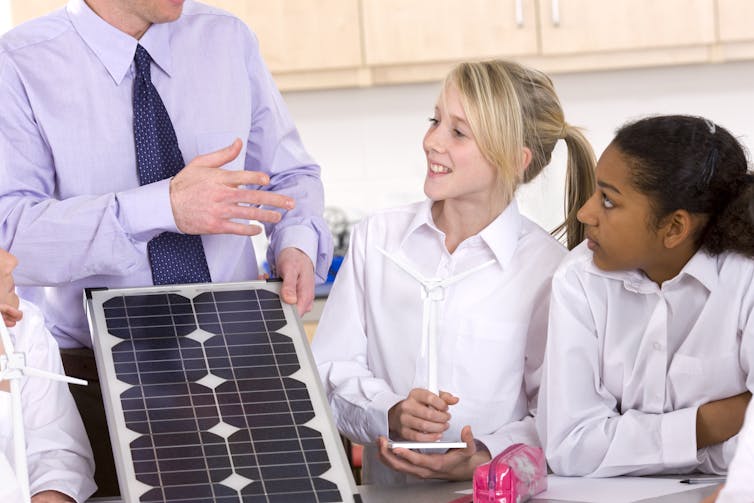YAKOBCHUK VIACHESLAV/Shutterstock
This week the UK government announced a £1 billion investment in new school construction and an additional £560 million for school repairs and upgrades. The funding is part of a package of spending proposals intended to stimulate the economy as Britain emerges from the coronavirus lockdown.
School repairs and new construction are essential. According to the National Audit Office, 60% of school facilities were built before 1976 and £6.7 billion will be needed to restore this deteriorating infrastructure. The pupil population is also growing – 640 new schools need to be built in England to keep up with demand.
This new school rebuilding effort is also an opportunity to invest in zero carbon schools. Green schools are a sound financial investment and will help the UK meet its commitment to net-zero greenhouse gas emissions by 2050. They can have a positive impact on how children learn and help incorporate sustainability into the curriculum.
How to build green schools
Guidance for schools provided by environmental organisation the Carbon Trust outlines the main components of a typical school’s carbon footprint. These are heating, lighting, hot water, catering, and electricity for information and communication technology (ICT).
To be green, a school would need to make every effort to decrease the energy demand for heating through insulation and double-glazed windows. Better controls and zoning – for example, the ability to control the temperature in a single classroom – would also greatly improve the energy performance of a school.

Air Images/Shutterstock
To bring down electricity use, schools should be using LED lighting and all ICT equipment needs to be switched off when possible. To go fully carbon neutral, schools would need to switch out their gas boilers for electric heat pumps. They would also need to provide on-site renewables, such as rooftop solar panels.
A cost-benefit analysis of green schools conducted in the US found that incorporating sustainability into school design increased the construction price by less that 2%. The first year of energy savings often covered this investment. It is also up to five times cheaper to construct a zero carbon building rather than retrofit a conventional building.
Improving the energy performance of schools is also critical if the UK is to achieve net-zero emissions by 2050. The Building Energy Efficiency Survey, conducted by the UK Department for Business, Energy and Industrial Strategy (BEIS), identified 6,760 GWh of potential energy savings in schools and indicated that education is the most cost effective sector for carbon reduction.
Recognising this potential, a recent BEIS competition involving smart metres targeted schools: one school was able to lower their gas costs by 35%.
A new way to learn
Green schools also provide an opportunity to make climate change a central part of the curriculum. Young climate activists are calling for reform of the education system to better address climate change.
Initiatives like LESS CO2, Energy Sparks and Solar for Schools are also helping schools connect the dots between the sustainability of school facilities and the opportunities to explore sustainability in the classroom.
Academic and environmentalist David Orr has highlighted the hidden curriculum of our current classrooms with the phrase “architecture as pedagogy”. This means that we learn things from the buildings in which we learn. A green school is the ideal environment for children to learn about sustainability.
Many of the techniques that make a school green, such as natural light and improved thermal comfort, also improve student outcomes. This approach to sustainable buildings is referred to as biophilic design. It has been shown that all academic subjects (not just science and geography) benefit when students learn in a well-designed green school.
The UK Sustainable Schools Alliance advocates for a whole school approach to sustainability which was developed by UNESCO. This model recognises that parents can learn about environmental issues from their children. Schools also play a critical role in their communities, and green schools can bring community members together to learn about sustainability and make their community more resilient.

Rawpixel.com/Shutterstock
A large number of school renewable energy projects involve community energy groups. This is an important development in local energy systems that results in direct community benefits.
The UK’s new school rebuilding effort must address the needs of the education sector, which includes rising to the challenge of climate change. Building green schools will provide a post-lockdown boost to the UK economy, and help put us on a path towards net-zero emissions by 2050.
![]()
William Finnegan receives funding from the Engineering and Physical Sciences Research Council (EPSRC).











